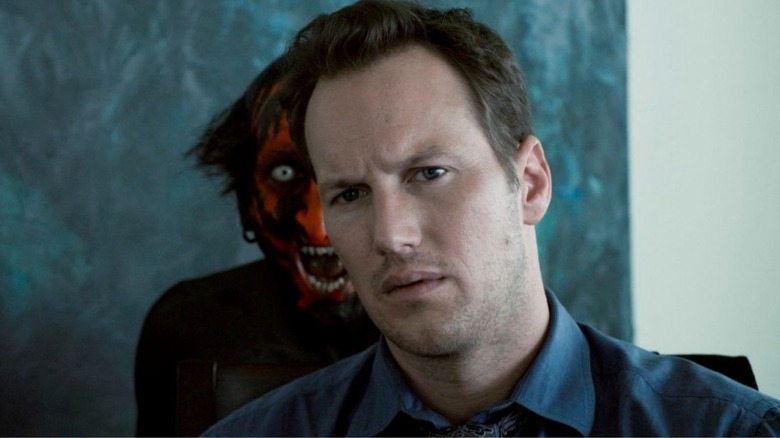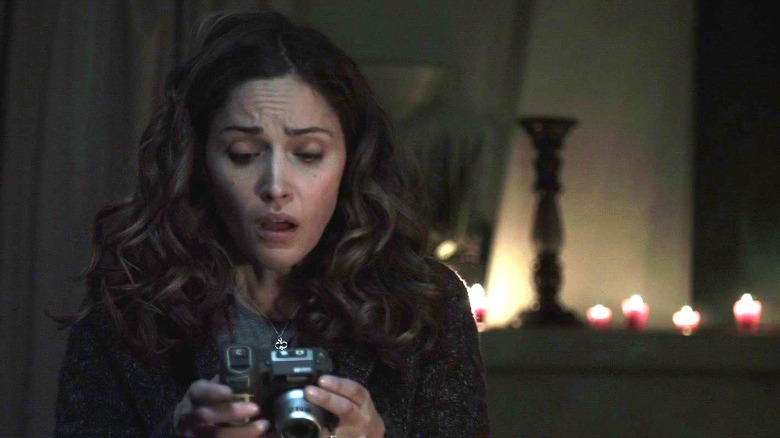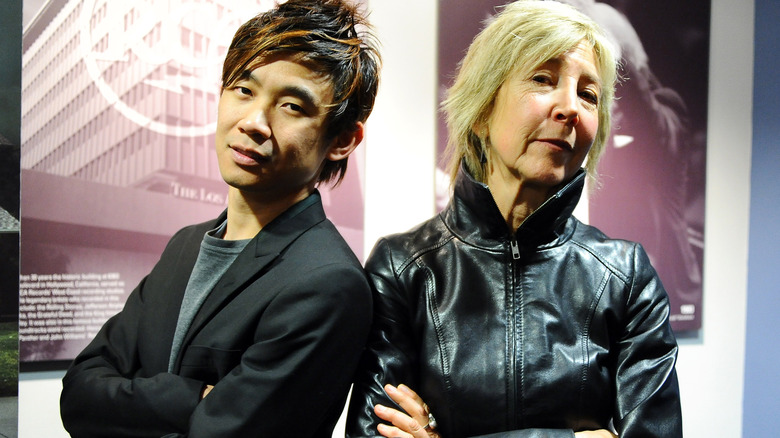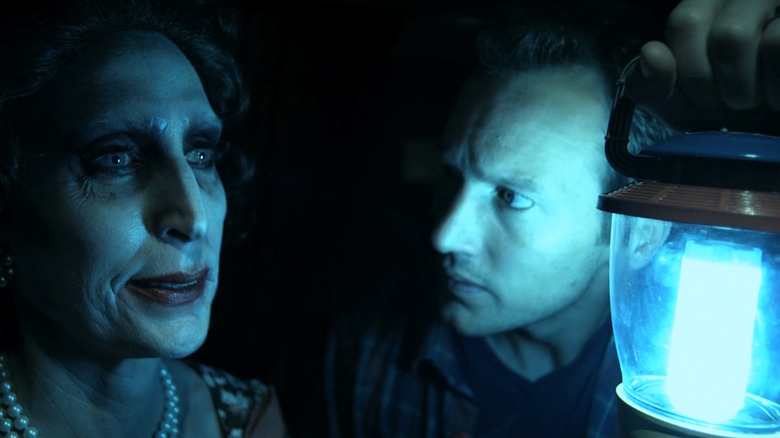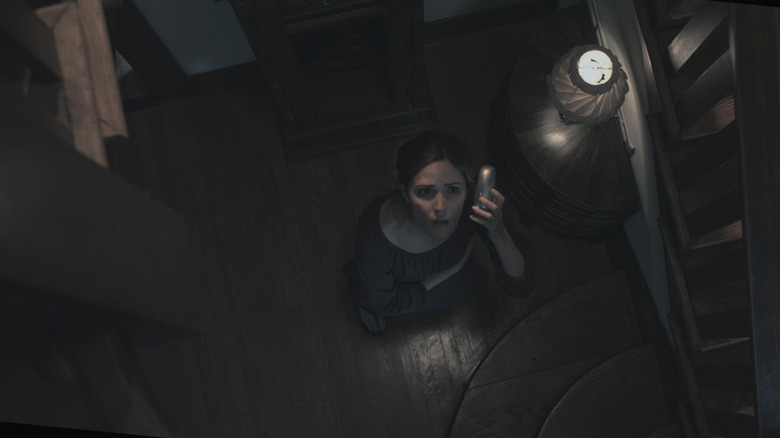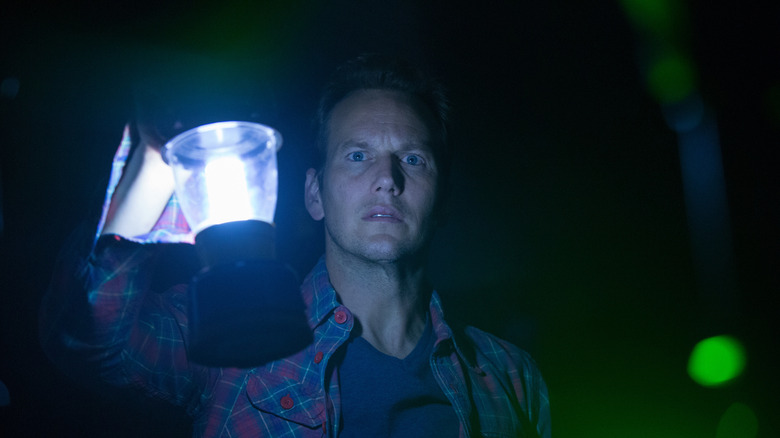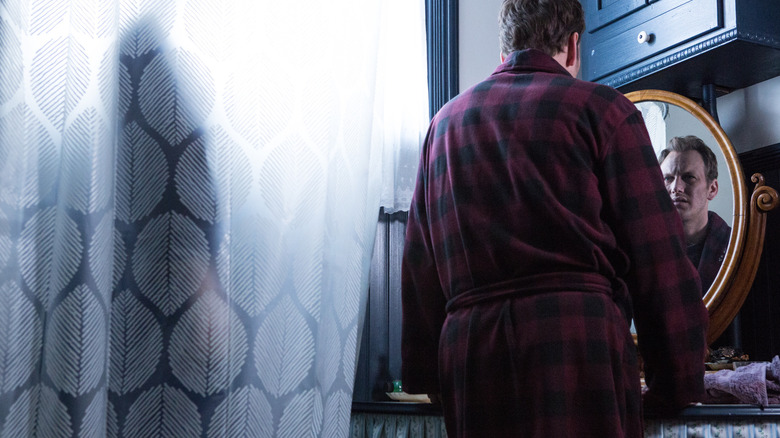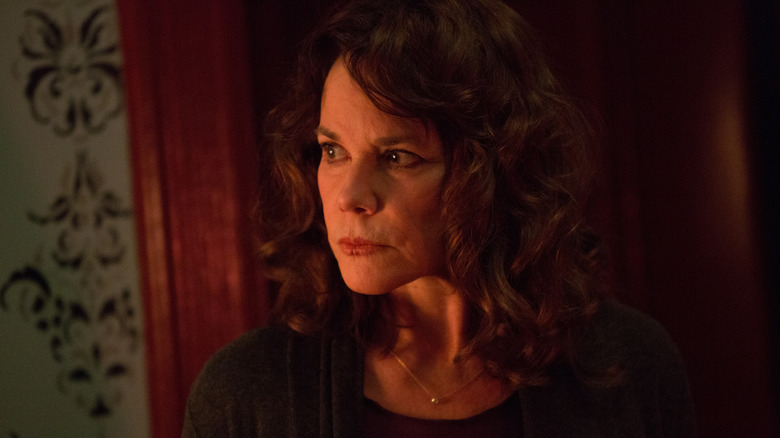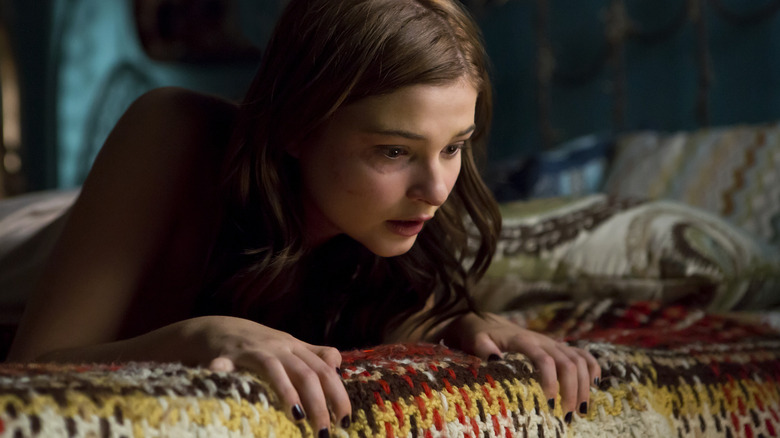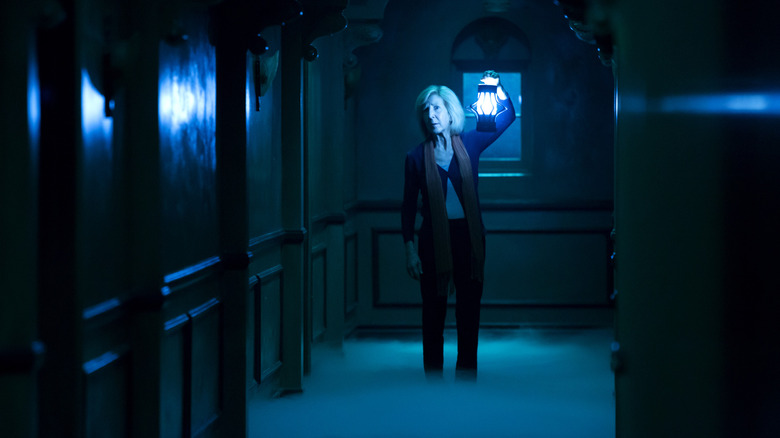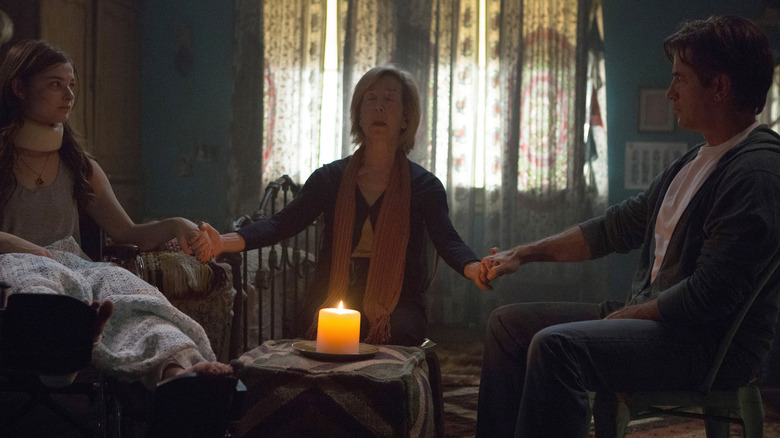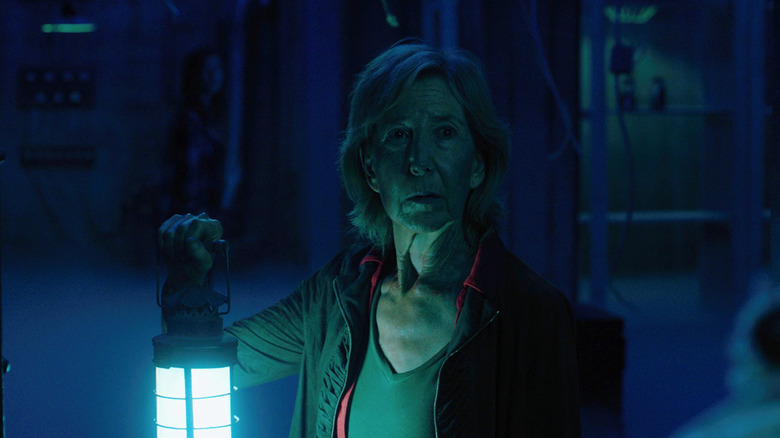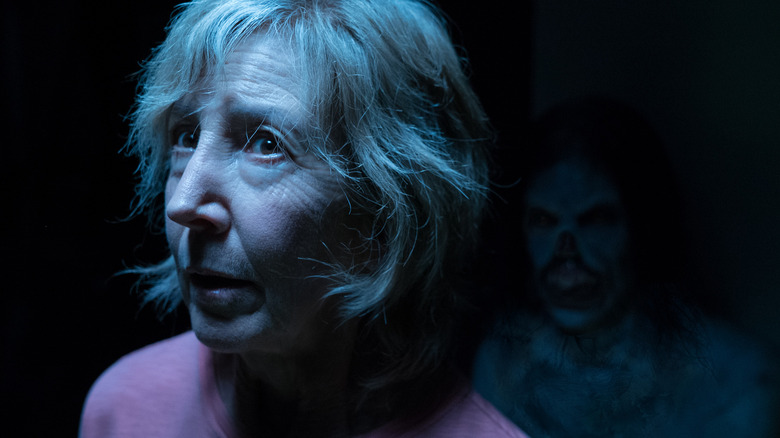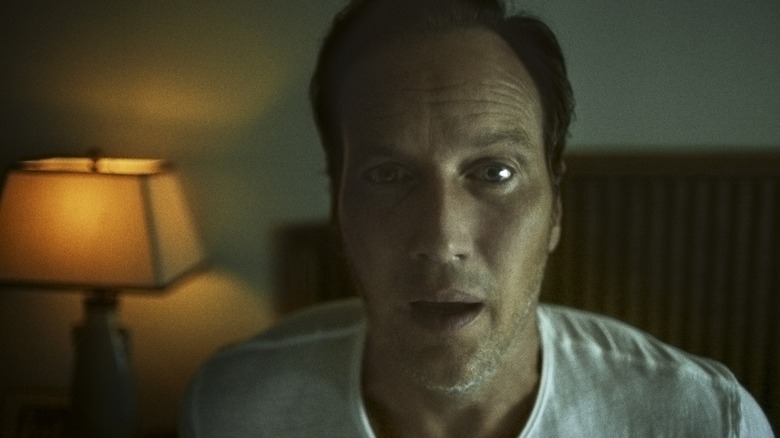The Untold Truth Of The Insidious Franchise
Things that go bump in the night have often been at the heart of classic horror movies. Within the "Insidious" movies, those bumping noises and other inexplicable aspects of everyday suburban life are revealed to belong to a world of ghosts existing right under our noses — we just can't see it. From there, storylines involving astral projection, paranormal investigators, and time travel have unfolded within this saga. Initially focusing on just one family trying to overcome the horrors of demonic possession, the "Insidious" saga soon expanded to include a pair of prequels and its most recent installment, "Insidious: The Red Door," which picks up a decade after the events of "Insidious: Chapter 2."
The "Insidious" franchise is packed with lore, demons, and scares, but they also feature lots of effort and very specific creative visions from the directors in charge. The untold truth of the "Insidious" movies reflects a wide assortment of behind-the-scenes details about these five horror features, including where the idea for "Insidious" came from in the first place, how director James Wan's experiences helming "The Conjuring" influenced his experiences directing "Insidious: Chapter 2," why Patrick Wilson made his directorial debut with "Insidious: The Red Door," and so much more.
How did Insidious come about?
For some devotees to the "Insidious" franchise, the only place a saga as terrifying as the "Insidious" movies could come from was the pits of one's very worst nightmares. However, "Insidious" was actually created under more mundane circumstances. Screenwriter Leigh Whannell revealed to The Film Stage how, when some producers of "Paranormal Activity," including Jason Blum, had founded the production outfit Blumhouse Pictures, there was only enough money to make five horror films. Blum was intrigued by the idea of working with Whannell and James Wan enough to ask if they'd make the first film to properly kick off this new horror division.
Needing an idea for such a momentous opportunity, Whannell and Wan turned to a concept they'd been nurturing for many years that bore more than a passing resemblance to the final version of "Insidious." Needing an idea for a movie right away so that this rare opportunity didn't pass them by, Whannell began penning the script for "Insidious" so that the movie could start shooting as soon as possible. For many moviegoers, the "Insidious" films represent terrifying visions into the chaotic and unknown. For the folks tasked with making the original "Insidious," though, the origins of this feature were an exciting chance to break new ground for Blumhouse.
James Wan was grateful for making the first Insidious outside the studio system
"Insidious" wasn't a project made for a major American movie studio, which explains its incredibly low budget and how it ended up getting distributed by tiny indie studio FilmDistrict. There are many hurdles with making low-budget independent films, including having fewer resources and shooting days at your disposal. Still, director James Wan said he appreciated that he got to make "Insidious" beyond the confines of the studio system since it gave him more creative freedom.
Wan explained to Collider that "Insidious" actually ended up costing less than the total cost of their earlier breakthrough horror film "Saw," and he also said such a tiny budget allowed him and Leigh Whannell to indulge in quieter scares that studio executives might have shied away from. Wan said he loved moments where a ghost would silently lurk in the back or walk in the background of a frame, without any visual or auditory emphasis on its presence. Wan said such subtle scares would've been eschewed had "Insidious" been crafted under the supervision of a major studio, especially given that he perceived most mainstream horror films to be way too reliant on just overwhelming the audience with noisiness and intrusive camerawork. Making "Insidious" on such a low budget wasn't without its challenges, but Wan said he saw it as the only way to properly make the movie inside his head.
James Wan wanted to make Insidious a bloodless counterpoint to the world of torture horror
James Wan's career was launched with the success of "Saw," a film that spawned a slew of sequels that kept ratcheting up the bloodshed from one installment to the next. In a landscape of horror films determined to be the next great torture horror feature, Wan wanted to offer up something different. Wan explained to The Film Stage that he was always frustrated with how people forgot that the original "Saw" was a largely violence-free affair more interested in psychological scares than guts spilling everywhere. With "Insidious," Wan wanted to make a movie that flaunted its blood-free scares that could offer something different in the horror movie scene.
Writer Leigh Whannell, meanwhile, also remarked that it really hit him and Wan midway through shooting "Insidious" that they were making something that didn't necessarily require an R-rating to be scary. Realizing this, the duo began dialing back some planned moments that could've jeopardized a PG-13 rating for "Insidious." For some filmmakers, committing to that softer rating could be seen as a sign of chickening out. For Wan and Whannell, though, it was merely a chance to do something different as horror artists.
Insidious wasn't originally built to spawn sequels
The original "Insidious" ends on a whopper of a cliffhanger depicting Patrick Wilson's Josh returning to the land of the living but also killing paranormal investigator Elise (Lin Shaye). He's now been possessed by the body of an evil spirit, a force that Renai (Rose Byrne) realizes has captured her husband just as the credits began to roll. It's a very melodramatic, open-ended conclusion that feels like it would belong at the end of any number of old-school drive-in horror films from back in the 1950s or '60s. Though it would seem like the kind of wrap-up built from the ground up to sustain a multitude of sequels, the creative team behind this initial feature insists that wasn't the intent.
Producer Oren Peli explained to The Film Stage when the first "Insidious" hit theaters that everybody involved in this original feature was solely focusing on getting "Insidious" out the door without focusing on plans for a sequel. Peli freely admitted the ending left the door open for a sequel but said he and the other members of the "Insidious" creative team wanted to focus on getting this movie right first before focusing on further follow-ups. Going this route proved beneficial for the "Insidious" saga in the long run, since "Insidious" ended up spawning four sequels and an in-development spin-off.
The Saw sequels inspired James Wan to helm the first Insidious sequel
After helming "Insidious," director James Wan shifted gears to another haunted house movie, "The Conjuring." Once he boarded this new project, one might imagine he had fully moved on from "Insidious." However, the first sequel in the "Insidious" saga, 2013's "Insidious: Chapter 2," saw Wan in the director's chair once again. It turns out another franchise Wan launched, the "Saw" movies, motivated him to return to "Insidious."
Wan explained to Complex that for years, he'd received criticism for the direction the "Saw" sequels went down despite that Wan only directed the first film. With "Insidious: Chapter 2," Wan said, he saw a chance to take more ownership of a franchise he spawned. Plus, the "Saw" franchise ended up exploring narrative paths that Wan said he felt the saga should've avoided. With "Insidious," Wan had the opportunity to nudge a larger cinematic story closer to his creative vision. Though Wan now had lots of responsibilities being the director of "The Conjuring," horrifying memories of how the "Saw" movies spun out of control kept him determined to work on "Insidious: Chapter 2."
James Wan found it tough to shoot Insidious 2 after directing The Conjuring
"Insidious: Chapter 2" was shot directly after "The Conjuring." Though both are haunted house horror movies, "The Conjuring" was a much more expensive major studio affair, which offered James Wan more resources than what he had on indie productions like "Insidious" and "Saw." After getting such lavish treatment on "The Conjuring," Wan suddenly was back in the world of tight schedules and minimal budgets with "Insidious: Chapter 2."
Wan told Bloody Disgusting he struggled to get back into the mindset of indie directing after his experiences with "The Conjuring" — a film with a $20 million budget. On "The Conjuring," Wan had the space to shoot scenes and performances exactly how he wanted, whereas "Insidious: Chapter 2" was a much more streamlined affair that required quick shooting and time constraints. The lucky thing was that Wan was working with actors he was deeply familiar with, since the original cast returned for the sequel. Still, Wan said of "Insidious: Chapter 2," "It was definitely one of the hardest movies I've ever had to make."
Why Insidious 2 was shot so quickly after this first movie
In the history of horror movie sequels, "Insidious: Chapter 2" didn't have the quickest turnaround time between its first and second installments. Most notably, the first and second entries in the "Saw" and "Paranormal Activity" franchises were released within about a year of each other. Still, the second "Insidious" film arrived roughly two and a half years after its predecessor, a relatively speedy process for delivering a sequel under normal circumstances. The popularity of the original "Insidious" undoubtedly propelled a speedy arrival for a follow-up, but there were also very practical reasons why "Insidious: Chapter 2" had to be made so quickly.
James Wan told IndieWire the plan for "Insidious: Chapter 2" was always to have this feature pick up directly from the cliffhanger ending of "Insidious." That made sense narratively, but it also meant they couldn't slack on making a sequel. Child actors from the original "Insidious" like Ty Simpkins were going to grow up quickly. If "Insidious: Chapter 2" wanted to believably look like it took place a short time after the initial "Insidious," there was a very limited window of time to accomplish that. With this urgency on everyone's mind, "Insidious: Chapter 2" was quickly assembled. The film was given the green light in November 2012 and moved rapidly through production, reaching completion in June 2013 for a September 2013 release.
Leigh Whannell didn't always intended to make Insidious 3 his directorial debut
"Insidious: Chapter 3" broke new ground for the "Insidious" saga in many ways, including being the first prequel in the franchise and the first entry in the series not helmed by James Wan. This director had moved on to grander sequels and directorial gigs, such as "Furious 7" (which dropped two months before "Insidious: Chapter 3") and "The Conjuring 2." With his schedule packed, a new filmmaker was brought in to take over directorial duties on the "Insidious" movies, though it was someone intimately familiar with the franchise. Leigh Whannell was upgraded from screenwriter and supporting actor in the first two installments to director for "Insidious: Chapter 3," which also marked his directorial debut.
Whannell told Den of Geek that making "Insidious: Chapter 3" his initial foray into filmmaking was not his initial plan and that he hoped to make an original feature his directorial debut. After all, directing an original film with "Saw" had worked out like gangbusters for his creative collaborator Wan. However, while writing "Insidious: Chapter 3," Whannell said he found that the script and story spoke to him the story and that he felt especially protective of the characters. If anybody was going to direct "Insidious: Chapter 3," it would need to be him.
Whannell found doing a prequel with Insidious 3 incredibly freeing
Throw a virtual rock on the internet and you're bound to hit someone with a long-standing grievance against the very concept of prequel movies. Prequels often struggle with dramatic tension since audiences already know where the story is going, and many prequels like the 2011 "The Thing" end up being hollow echoes of earlier, superior works. It's easy to imagine that track record was daunting to Leigh Whannell as he prepared to direct "Insidious: Chapter 3," the first prequel in the "Insidious" saga.
However, Whannell told Den of Geek that he relished the unique creative elements of engaging in a prequel. Whannell said he loved that he could just focus on a new family of characters rather than have to be constrained by the pre-established mythology and character beats of the first two "Insidious" movies. Whannell said there were some challenges in navigating a prequel, though, namely in trying to make something new that could live up to the original "Insidious" titles. But the virtues of getting to make something fresh made Whannell a rare fan of the possibilities of prequels.
Elise was never meant to be an Insidious protagonist
In the original "Insidious," Lin Shaye's Elise stands out as easily the most interesting character in the movie. Partially because of Shaye's compelling performance and all the possibilities in her years of off-screen experience dealing with paranormal entities, Elise captures the imagination like no other character in "Insidious." Tragically, that first film ends with her sudden murder, which, on paper, writes her out of this horror series. However, "Insidious: Chapter 3" used the premise of a prequel to not only depict a living and breathing Elise but to also make her the protagonist of the story.
It's a dramatic upgrade for a character who was never meant to be so notable in the "Insidious" mythology. Leigh Whannell told Den of Geek that when he was writing the original "Insidious," he never thought of Elise as an especially important character. However, while shooting the feature, Whannell said Shaye brought such a magnetic performance that gave Elisa extra personality. Fans also took to the character so profoundly that Whannell realized that the third film had to make Elise the protagonist. "In the 'Insidious' world, I found the fans of the film connected with Elise despite us," he said. "We weren't intending for her to be the star of the franchise, but something just clicked."
How did Adam Robitel get the gig of helming Insidious: The Last Key?
After Leigh Whannell made his directorial debut in "Insidious: Chapter 3," he moved on to original projects like "Upgrade." This meant that another replacement for him and original "Insidious" helmer James Wan would need to be sought out for the fourth installment in the franchise, "Insidious: The Last Key." Another prequel focusing on the exploits of Elise, "The Last Key" was eventually helmed by Adam Robitel. Director of the 2014 horror film "The Taking of Deborah Logan," Robitel already had experience with Blumhouse horror titles thanks to a screenwriting credit on the 2015 title "Paranormal Activity: The Ghost Dimension."
It wasn't just experience with horror films that got Robitel the "Last Key" gig, though. Robitel told Collider that prior to securing this job, he had experience with both Wan and Lin Shaye — Shaye would invite Robitel and others to her house for dinner, and he met Wan through her. That put Robitel on Wan's radar and made the budding filmmaker a strong candidate to take over the "Insidious" saga from Whannell. After putting together a presentation about what his particular "Insidious" movie would look like, Robitel was selected for the job and quickly got to work realizing "Insidious: The Last Key." Thanks to his pre-existing rapport with key "Insidious" creative figures Wan and Shaye, entering this expansive horror saga was easy for franchise newcomer Robitel.
The process of getting the design of The Last Key's demon just right
The designs of the "Insidious" demons and ghosts are as scary as they are distinctive and memorable. This extends to the villainous demon from the first movie, a critter that bears more than a passing resemblance to Darth Maul and Satan. "Insidious: Chapter 2," meanwhile, utilizes a pale-faced woman briefly glimpsed at in the first movie who ends up having a somewhat problematic backstory. These boldly designed creatures have their share of fans and detractors, but their extremely pronounced appearances meant any future "Insidious" movies would need to work overtime to make their respective paranormal entities unique-looking.
Director Adam Robitel recounted to Rue Morgue that the primary demon of "The Last Key" didn't initially exist when he joined the production. "For me it was like I really wanted something iconic in terms of a demon," he told Collider. "I always think of the Lipstick Demon or Man Who Can't Breathe, I felt like an 'Insidious' movie needed that." He said he and Leigh Whannell eventually worked a chilling creature with keys for fingers into the story. For Robitel, that design tapped into something all viewers find eerie, reflected the themes of the film, and helped ensure "The Last Key" carries on the tradition of the franchise's frightening demons.
What drew Patrick Wilson to stepping behind the camera on Insidious: The Red Door
In addition to reprising the role of Josh in the fifth installment in the "Insidious" saga, "Insidious: The Red Door," Patrick Wilson directs the film, too, marking his directorial debut. It was a big step for Wilson, particularly given that he would be following well-known "Insidious" helmers like James Wan and Leigh Whannell. However, Wilson said he kept his mind off living up to the legacy of earlier "Insidious" movies and instead concentrated on the qualities of "The Red Door" that inspired him to step behind the camera in the first place.
Specifically, Wilson told GameSpot that the idea of exploring Josh and his family's lingering trauma proved so fascinating that he just knew he had to take on directorial duties on "The Red Door." "I really wanted to unpack the second movie and address the trauma," he said. "That's the only way that I knew how to make a movie that I was passionate about, that I felt like I had any authority to make." Wilson said he's lucky to be working with actors and artists he was already comfortable with, in a franchise that already has an established fanbase.
